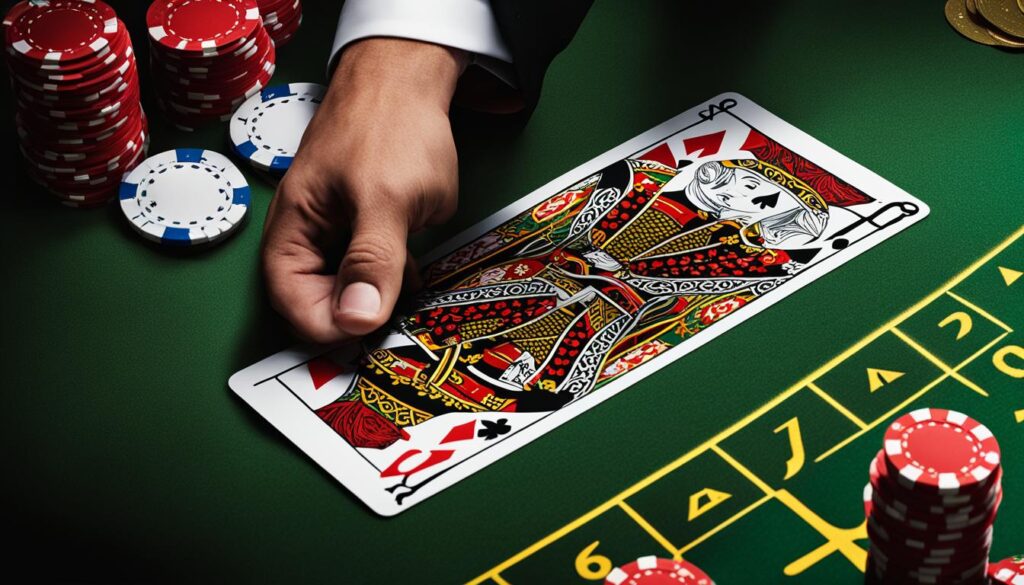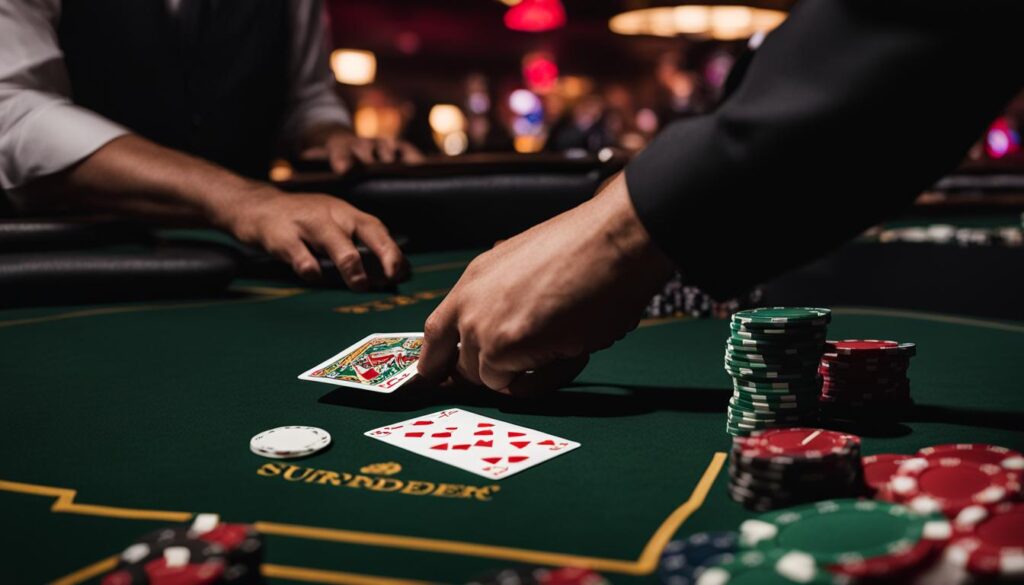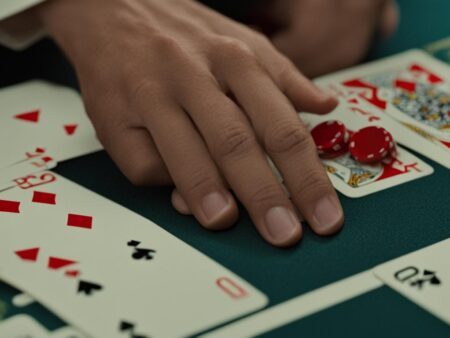Blackjack is a thrilling casino game that combines strategy and skill. To increase your chances of winning, it’s crucial to know the best hands and strategies to implement at the table. In this article, we will explore the top hands in blackjack and provide you with winning strategies to enhance your gameplay.
Key Takeaways:
- Knowing the best hands in blackjack can significantly improve your chances of winning.
- Always double down on a hard 11 to maximize your profits.
- Splitting a pair of 8s and Aces can lead to significant gains.
- Never split a pair of 5s or tens for a stronger hand.
- When facing a dealer’s 2 or 3 upcard, it’s best to hit a hard 12.
Blackjack Strategies: Always Double Down on a Hard 11
When it comes to playing blackjack, having effective strategies can greatly improve your chances of winning. One such strategy is to always double down on a hard 11. This means that if the total value of your initial hand is 11 and does not include an Ace, it’s highly recommended to double your bet.
By doubling down on a hard 11, you are taking advantage of a favorable situation. Statistically, an 11-point hand offers a high probability of hitting either a 10 or an Ace, both of which will give you a strong total hand value of 21 or 12. Additionally, the dealer is more likely to bust when facing a 2 through 6 upcard, further increasing your chances of winning.
To illustrate the effectiveness of this strategy, let’s take a look at the following table:
| Dealer’s Upcard | Player’s Hand | Recommended Action |
|---|---|---|
| 2 | Hard 11 | Double Down |
| 3 | Hard 11 | Double Down |
| 4 | Hard 11 | Double Down |
| 5 | Hard 11 | Double Down |
| 6 | Hard 11 | Double Down |
As you can see, regardless of the dealer’s upcard in the range of 2 to 6, it is optimal to double down on a hard 11. This strategy maximizes your potential winnings and puts you in a strong position against the dealer. Remember, always stick to your strategy and avoid deviating based on emotions or gut feelings.
“Doubling down on a hard 11 is a smart move in blackjack. It capitalizes on the likelihood of hitting a high-value card and takes advantage of the dealer’s weak upcard. By doubling down, you increase your bet and give yourself an excellent opportunity to win big.”
Always Split a Pair of 8s and Aces
When it comes to playing blackjack, one of the most important strategies to remember is to always split a pair of 8s and Aces. These two starting hands have the potential to significantly increase your chances of winning and maximize your profits. Let’s take a closer look at each of these hands and why splitting them is the optimal move.
First, let’s talk about a pair of 8s. When you are dealt two 8s, you have a total hand value of 16, which is considered a weak hand in blackjack. By splitting the 8s into two separate hands, you give yourself a chance to improve your position. Each 8 becomes the starting card for a new hand, and you can place an additional bet on the second hand. This gives you two opportunities to receive a high-value card and potentially turn a losing hand into a winning one.
Now let’s move on to the Aces. When you are dealt a pair of Aces, you have a total hand value of 12. While a 12 is not the strongest hand, splitting Aces can lead to significant gains. When you split Aces, you are essentially creating two starting hands with the potential for a natural blackjack (an Ace and a 10-value card). This is the strongest hand in blackjack and pays out at a higher rate. By splitting Aces, you increase your chances of forming one or even two blackjack hands, which can result in substantial winnings.
Splitting a pair of 8s and Aces is not only a strategic move but also a statistically sound decision based on the probabilities of the game. It allows you to take control of weak starting hands and potentially turn them into winning combinations. Remember, blackjack is a game of skill and strategy, and by following these optimal strategies, you can improve your chances of success at the blackjack table.
Never Split a Pair of 5s or Tens
When it comes to splitting pairs in blackjack, it is generally a sound strategy to separate certain cards and increase your chances of winning. However, there are exceptions to this rule. One such exception is to never split a pair of 5s or tens. In most circumstances, keeping these pairs together as a hard 10 or 20 respectively gives you a stronger hand and a higher chance of winning.
Splitting a pair of 5s would result in two hands with a starting value of 5, which puts you at a disadvantage. It is difficult to improve these hands without the risk of busting, and you have a higher likelihood of ending up with two weak hands that have a higher probability of losing to the dealer.
Similarly, splitting a pair of tens, which gives you a total value of 20, is not advisable. A total value of 20 is considered a strong hand in blackjack, and splitting it would only decrease your chances of winning. By keeping the pair of tens together, you have a higher likelihood of beating the dealer and securing a win.
| Pair of 5s | Pair of Tens |
|---|---|
| Avoid splitting | Avoid splitting |
| Keep as a hard 10 | Keep as a hard 20 |
| Higher chance of winning | Higher chance of winning |
“Never splitting a pair of 5s or tens is a fundamental principle of blackjack strategy. By keeping these pairs together, you maintain stronger hands and increase your odds of winning against the dealer.”
Remember, in blackjack, the goal is to have a higher hand value than the dealer without exceeding 21. Keeping a pair of 5s as a hard 10 or a pair of tens as a hard 20 gives you a solid foundation to build upon. So, when you’re dealt a pair of 5s or tens, resist the urge to split and trust in the strength of these pairs to guide you towards victory.
Always Hit a Hard 12 Against Dealer’s 2 or 3 Upcard
When it comes to playing blackjack, knowing the optimal hands to play can greatly improve your chances of winning. In this section, we will discuss the strategy of hitting a hard 12 against a dealer’s 2 or 3 upcard. While it may seem counterintuitive to hit on a hand that totals 12, there are specific circumstances where doing so can give you the best chance of winning.
When the dealer shows a 2 or 3 as their upcard, they have a fairly weak starting hand. By hitting on your hard 12, you have the opportunity to improve your hand and potentially beat the dealer. While there is a risk of busting, the chances of improving your hand outweigh the risk in this situation.
It’s important to note that this strategy applies specifically to a hard 12. If you have a soft 12 (a hand that contains an Ace), it is generally recommended to stand rather than hit. This is because the Ace can be counted as either 1 or 11, giving you more flexibility and a better chance of improving your hand without the risk of busting.
| Player’s Hand | Dealer’s Upcard | Optimal Strategy |
|---|---|---|
| Hard 12 | 2 or 3 | Hit |
“When the dealer shows a 2 or 3, hitting on a hard 12 gives you the best chance of improving your hand and beating the dealer. While there is a risk of busting, the potential reward makes it the optimal play.” – Blackjack Expert
By following this strategy and hitting on a hard 12 against a dealer’s 2 or 3 upcard, you increase your chances of getting a stronger hand and ultimately winning the round. Remember, blackjack is a game of strategy and making the right decisions can greatly impact your overall success at the table.
Always Hit Ace-7 (Soft 18) Against Dealer’s 9, 10, or Ace Upcard
When playing blackjack, there are certain hands that give players a significant advantage over the dealer. One such hand is the Ace-7, also known as a soft 18. In this situation, it is always recommended to hit when the dealer shows a 9, 10, or an Ace as their upcard.
The reason behind this strategy is that hitting allows players to potentially improve their hand and increase their chances of beating the dealer. By taking an additional card, players have the opportunity to get closer to a higher value hand, such as a total of 19 or 20.
When the dealer shows a 9, 10, or an Ace as their upcard, they have a strong hand and are more likely to make a total of 19 or higher. To have a fighting chance against the dealer’s strong hand, players need to aim for a higher-value hand themselves.
By hitting the Ace-7, players can increase their chances of getting a stronger hand without the risk of busting, as the Ace can be counted as either 1 or 11. This flexibility gives players an advantage and allows them to adapt their strategy based on the cards they receive.
Remember, always hit an Ace-7 (soft 18) against a dealer’s 9, 10, or Ace upcard. Hitting gives you the best chance of improving your hand and beating the dealer’s strong hand.
In summary, when facing a dealer’s 9, 10, or an Ace upcard, hitting an Ace-7 (soft 18) is the optimal strategy. By taking an additional card, players increase their chances of getting closer to a higher-value hand and potentially beating the dealer. With this knowledge and the right strategy in place, players can make the most out of their blackjack gameplay and increase their chances of winning big.
Always Double Down on 10 Against Dealer’s 9 or Less Upcard
One of the optimal blackjack hands is a total of 10 when the dealer’s upcard is a 9 or less. In this situation, it is highly recommended to double down on your bet. By doubling down, you have the opportunity to capitalize on the favorable odds and potentially increase your winnings.
Doubling down on a total of 10 against a dealer’s 9 or less is a strategic move that takes advantage of the probabilities in the game. The logic behind this strategy is that the dealer is more likely to bust when their upcard is low. By doubling down, you increase your bet size and stand a higher chance of winning the hand.
When you double down, you are committing to taking one more card and then standing. This strategy is most effective when the dealer’s upcard is weaker, as it gives you a better chance of beating their hand. It’s important to note that not all blackjack games allow you to double down, so be sure to check the rules before implementing this strategy.
| Your Hand | Dealer’s Upcard | Optimal Move |
|---|---|---|
| 10 | 2 | Double Down |
| 10 | 3 | Double Down |
| 10 | 4 | Double Down |
| 10 | 5 | Double Down |
| 10 | 6 | Double Down |
| 10 | 7 | Double Down |
| 10 | 8 | Double Down |
| 10 | 9 | Double Down |
By following this blackjack strategy of always doubling down on a 10 against a dealer’s 9 or less upcard, you can increase your potential winnings and improve your overall gameplay. Remember to practice responsible gambling and adhere to your betting limits to ensure a positive experience at the blackjack table.
Strategies for Dealing with Soft 17 Rule
When playing blackjack and faced with the dealer’s soft 17 rule, it is crucial to have a solid strategy in place to maximize your chances of winning. In this section, we will explore some effective strategies that can help you navigate this rule and make informed decisions during gameplay.
Double Down on Hard 11 Against the Dealer’s Ace
One key strategy when the dealer must hit on soft 17 is to double down on a hard 11 when the dealer’s upcard is an Ace. By doubling down in this situation, you are taking advantage of the favorable odds and increasing your potential winnings.
Double Down on Soft 19 Against the Dealer’s 6
Another effective strategy in dealing with the soft 17 rule is to double down on a soft 19 when the dealer’s upcard is a 6. This move puts you in a strong position, as the dealer’s chances of improving their hand are relatively low.
Hit with Ace-7 Against the Dealer’s 2 Upcard
When the dealer is showing a 2 as their upcard, hitting with an Ace-7 (soft 18) can be a smart move. By hitting in this scenario, you give yourself the opportunity to improve your hand and potentially achieve a stronger total than the dealer.
Overall, when facing the soft 17 rule, it is important to adjust your strategy accordingly. Double down on favorable hands like hard 11 and soft 19, and consider hitting rather than standing in specific situations. By following these strategies, you can enhance your chances of success and make the most out of your blackjack gameplay.
Always Double Down A-2 through A-7 Against 5 or 6 Upcard

When playing blackjack, there are certain hands that give you a strong advantage. One such hand is when you have a soft total of A-2 through A-7 (soft 13-18) and the dealer’s upcard is 5 or 6. In this situation, it is highly recommended to double down on your bet. Doubling down allows you to increase your wager and receive one additional card. By taking this action, you can capitalize on the favorable odds and maximize your potential winnings.
When you have a soft total of A-2 through A-7, doubling down against a dealer’s 5 or 6 upcard is a strategic move for several reasons. Firstly, when the dealer shows a 5 or 6, they are more likely to bust, as these cards often lead to a hand total that requires them to draw additional cards. By doubling down, you can take advantage of this potential bust and increase your chances of winning the hand.
Additionally, by doubling down with a soft total of A-2 through A-7, you are positioning yourself to potentially improve your hand to a stronger total. Since you have an Ace in your hand, you have the flexibility to count it as either 1 or 11, depending on the value that benefits you the most. Doubling down gives you the opportunity to draw a high-value card, such as a 10 or a face card, which would significantly enhance your hand and put you in a favorable position against the dealer.
Table: Double Down A-2 through A-7 Against 5 or 6 Upcard
| Player’s Hand | Dealer’s Upcard | Action |
|---|---|---|
| A-2 to A-7 (soft 13-18) | 5 or 6 | Double Down |
Remember, the decision to double down on A-2 through A-7 against a dealer’s 5 or 6 upcard is based on statistical analysis and optimal blackjack strategy. By following this strategy, you can increase your chances of winning and potentially walk away from the table with more money in your pocket. Keep in mind that it’s important to understand and employ the correct doubling down strategy for each specific hand in order to make the most informed decisions during your blackjack gameplay.
Stand with a Pair of 9s Against a 7 Upcard
In blackjack, it’s essential to make strategic decisions based on the dealer’s upcard. When you are dealt a pair of 9s and the dealer’s upcard is a 7, it is recommended to stand rather than split. By standing, you retain your pair of 9s as a strong starting hand, increasing your chances of beating the dealer’s hand and minimizing your losses.
Standing with a pair of 9s against a 7 upcard is a smart move because it gives you a higher probability of achieving a winning hand. Splitting the pair would separate the 9s into two separate hands, each starting with a value of 9. While splitting can be advantageous in certain situations, it is less beneficial when facing a 7 upcard from the dealer.
By standing, you maintain a hand with a value of 18, which puts you in a favorable position. The dealer’s upcard of 7 suggests a strong starting hand, and splitting your 9s would result in two weaker hands that may struggle to beat the dealer’s total. By standing, you have a higher chance of achieving a total closer to 21 while forcing the dealer to take additional cards and potentially bust.
Remember, standing with a pair of 9s against a 7 upcard is a decision based on probability and optimal blackjack strategy. It provides you with a solid foundation to build upon and increases your chances of coming out ahead in the game.
Blackjack Hand Rankings
Understanding blackjack hand rankings is crucial for making informed decisions at the table. Here is a breakdown of the basic hand rankings in blackjack:
- Natural Blackjack (Ace + 10-value card) – The highest-ranking hand, it consists of an Ace and any 10-value card (10, Jack, Queen, or King).
- Hard Hands – These hands do not contain an Ace or contain an Ace counted as 1 point. Examples include a hard 12 or hard 17.
- Soft Hands – These hands contain an Ace counted as 11 points. Examples include Ace-6 (soft 17) or Ace-8 (soft 19).
- Pairs – These hands consist of two cards of the same rank, such as a pair of 9s or a pair of Aces. Pairs can be split into two separate hands in certain situations.
Knowing the hand rankings helps you assess the value of your hand and make the appropriate strategic choices during gameplay. When faced with a pair of 9s and a dealer’s upcard of 7, standing is the recommended move based on the probabilities and hand rankings.
Surrender Strategy Tips

When playing blackjack, understanding the surrender option can be a valuable tool in your strategy. Surrendering allows you to give up your hand and recoup half of your bet. By utilizing this option in certain scenarios, you can minimize potential losses and make more informed decisions.
One effective surrender strategy is to surrender a hard 16 against a dealer’s 9, 10, or Ace upcard. This is because a hard 16 has a high chance of busting and is difficult to improve. By surrendering in this situation, you can save half of your bet and avoid the risk of losing your entire wager.
Another situation where surrendering is advantageous is when you have a hard 15 against a dealer’s 10 upcard. With a hard 15, your chances of improving the hand are limited, and going against a dealer’s strong upcard poses a significant risk. By surrendering, you can cut your losses in half and preserve your bankroll.
It’s important to note that not all blackjack variants offer the surrender option, so be sure to check the rules of the specific game you are playing. Additionally, surrendering should be used strategically and selectively, as surrendering too often can lead to missed opportunities for potential wins.
| Situation | Recommendation |
|---|---|
| Hard 16 against a dealer’s 9, 10, or Ace upcard | Surrender |
| Hard 15 against a dealer’s 10 upcard | Surrender |
“Surrendering in blackjack is like folding in poker – it’s a strategic move to minimize potential losses. By surrendering in the right situations, you can make smarter decisions and manage your bankroll effectively.” – Expert Blackjack Player
Never Make the Insurance Bet
When it comes to playing blackjack, there are certain strategies that can increase your chances of winning. However, one bet that we strongly advise against is the insurance bet. The insurance bet is a side bet that you can make when the dealer’s upcard is an Ace. This bet pays 2 to 1 if the dealer has a natural blackjack (a hand with a value of 21). While it may seem tempting to protect yourself against the dealer’s potential blackjack, the reality is that the insurance bet is not a profitable option in the long run.
Statistically speaking, the odds are not in your favor when you make the insurance bet. The house edge on the insurance bet is significantly higher compared to other bets in blackjack, meaning that you are more likely to lose money in the long term by making this bet. The insurance bet may give you a false sense of security, but it is important to remember that blackjack is a game of skill and strategy, not luck or insurance.
Instead of making the insurance bet, focus on playing optimal blackjack hands and following proven strategies. By doubling down on the right hands, splitting pairs strategically, and hitting or standing when appropriate, you can maximize your chances of winning and minimize your losses. It is crucial to make decisions based on the strength of your hand and the dealer’s upcard, rather than relying on the insurance bet.
Quote:
“The insurance bet is a sucker bet. It may seem like a good idea to protect yourself, but in reality, it is a losing proposition. Stick to sound blackjack strategies and make decisions based on the strength of your hand and the dealer’s upcard.”
Remember, the goal in blackjack is to beat the dealer’s hand without going over 21. Making the insurance bet does not improve your chances of achieving this goal. Instead, it is more profitable to focus on playing the optimal hands, following proven strategies, and making informed decisions throughout the game. By avoiding the insurance bet, you can stay on the path to success and increase your chances of coming out ahead at the blackjack table.
Don’t Play a 6 to 5 Blackjack Game
When it comes to playing blackjack, it’s crucial to be aware of the variations in the game and the rules that can significantly impact your chances of winning. One important rule to watch out for is the 6 to 5 blackjack game. In this game, a winning blackjack hand is paid out at a ratio of 6 to 5, instead of the traditional 3 to 2 payout.
This might seem like a small difference, but it actually has a significant impact on your overall winnings. The 6 to 5 payout drastically increases the house edge, making it much harder for players to come out ahead. In fact, playing a 6 to 5 blackjack game can increase the house edge by as much as 1.39% compared to a standard 3 to 2 game.
Let’s take a look at the numbers to illustrate this point:
| Blackjack Payout | House Edge |
|---|---|
| 3 to 2 | 0.40% |
| 6 to 5 | 1.79% |
As you can see, the difference in payout may seem insignificant, but it actually has a substantial impact on your chances of winning in the long run. By playing a 6 to 5 blackjack game, you are essentially giving the casino a higher advantage and reducing your own odds of success.
To maximize your chances of winning, it’s best to stick to games that offer the traditional 3 to 2 payout for a blackjack hand. These games provide better odds and a more favorable playing environment, giving you a stronger chance of coming out ahead.
Conclusion
When it comes to playing blackjack, having a solid betting strategy and knowing the optimal hands to play can greatly improve your chances of winning. By following our recommended strategies, you can maximize your profits and minimize your losses.
Always remember to double down on a hard 11, as this is one of the best blackjack hands to have. By doubling your bet in this situation, you increase your potential winnings and take advantage of the favorable odds.
Additionally, splitting a pair of 8s and Aces can lead to significant gains. By separating these pairs into two hands, you give yourself more opportunities to win money and cut your losses when necessary.
Lastly, it is important to make strategic decisions based on the dealer’s upcard. Pay attention to when it’s best to hit or stand, and when to double down or surrender. By understanding the optimal blackjack hands in different scenarios, you can make informed decisions that increase your chances of success.
FAQ
What are some of the best starting hands in blackjack?
Splitting a pair of 8s and Aces is considered one of the best starting hands in blackjack.
Should I always split certain pairs in blackjack?
While it is generally advisable to split certain pairs, you should never split a pair of 5s or tens.
What should I do with a hard 12 against a dealer’s 2 or 3 upcard?
It is best to hit rather than stand in this situation, as it gives you a better chance of improving your hand and beating the dealer.
What should I do with an Ace-7 (soft 18) against a dealer’s 9, 10, or Ace upcard?
It is advantageous to hit rather than stand, as hitting increases your chances of getting closer to a higher value hand and potentially beating the dealer.
Should I double down on a total of 10 against a dealer’s 9 or less upcard?
Yes, it is recommended to double down in this situation to take advantage of the favorable odds and potentially win more money.
What strategies should I follow when the dealer must hit on a soft 17?
Strategies to follow include doubling down on a hard 11 against the dealer’s Ace, doubling down on a soft 19 against the dealer’s 6, and hitting with Ace-7 against the dealer’s 2.
Should I double down with a soft total of A-2 through A-7 against a dealer’s 5 or 6 upcard?
Yes, in most cases it is advantageous to double down in this situation to increase your chances of winning.
What should I do with a pair of 9s against a dealer’s 7 upcard?
It is recommended to stand rather than split, as standing gives you a higher chance of beating the dealer’s hand.
Is surrendering a viable option in blackjack?
Yes, surrendering can be a smart move in certain situations, such as surrendering a hard 16 against a dealer’s 9, 10, or Ace upcard, as well as a hard 15 against a dealer’s 10 upcard.
Should I make the insurance bet in blackjack?
It is generally advised to never make the insurance bet, as the odds are not in your favor. Focus on your own hand and make decisions based on optimal strategies.
Should I play a 6 to 5 blackjack game?
It is important to avoid playing a 6 to 5 blackjack game, as the payout for a winning blackjack hand is significantly lower. Stick to games that offer the traditional 3 to 2 payout for a blackjack hand.







